Major fruit crops production in Bangladesh and their relationships with socio-ecological vulnerabilities
Article Information
Jatish Chandra Biswas1, Md. Maniruzzaman2, Md Mozammel Haque3*, Md. Belal Hossain4, Abdul Hamid5, Naveen Kalra6
1Coordinator CRP-2 project, second phase, Krishi Gobeshona Foundation, Farmgate, Dhaka, Bangladesh
2Bangladesh Rice Research Institute, Joydebpur, Gazipur-1701, Bangladesh
3Bangladesh Rice Research Institute, Regional Station, Habiganj, Bangladesh
4Bangladesh Rice Research Institute, Joydebpur, Gazipur-1701, Bangladesh
5Agrarian Research Foundation, 5/10B, Block A, Lalmatia, Dhaka 1207, Bangladesh
6Adjunct Faculty, Systems Design Engineering, University of Waterloo, ON, Canada
*Corresponding Author: Md Mozammel Haque, Bangladesh Rice Research Institute, Regional Station, Habiganj, Bangladesh
Received: 16 May 2021; Accepted: 24 May 2021; Published: 16 June 2021
Citation:
Jatish Chandra Biswas, Md. Maniruzzaman, Md Mozammel Haque, Md. Belal Hossain, Abdul Hamid, Naveen Kalra. Major fruit crops production in Bangladesh and their relationships with socio-ecological vulnerabilities. Journal of Food Science and Nutrition Research 4 (2021): 131-143.
Share at FacebookAbstract
Many nutrient rich fruits are grown in Bangladesh, but consumption is less than half of the daily requirement. Such situations are worst depending on growing seasons, natural hazards and localities of the country. The climate extremes are increasing globally including Bangladesh and damaging crops severely. So, the impacts of climate extremes on fruit crop losses and socio-ecological vulnerability were investigated in the present investigation. The socio-ecological vulnerable zones were determined based on minimum of 10 attributes, arithmetic, geometric and weighted mean scores and maps were prepared using IDRISI3.2. Banana, mango, watermelon, pineapple, and jackfruit covered the highest areas in Bangladesh. Total fruit production varied from <20000 tons to >600000 tons depending on location of gardens and its size. North-east, south and south-east coastal regions of Bangladesh are moderate to very highly socio-ecologically vulnerable for fruit production. Most safe zones for fruit cultivation are situated in major hilly, parts of north-west and a few districts in central region in Bangladesh. Fruit crop area damages were the highest in Khulna division. Hailstorms were dominating hazards responsible for 28.83% losses followed by thunderstorms (14.73%), cyclone (14.54%) and salinity (10.86%). Based on economic losses, about 67% areas of the country are moderate to highly vulnerable for fruit cultivation. Major hilly, parts of north-west and part of central regions are safe for fruit production of country. Damages from climate extremes can be minimized by changing sowing times, selection of hazard tolerant varieties, making physical barriers, early warning for disaster preparedness and community based disaster management.
Keywords
Mango, Banana, Jackfruit; Climate extremes; Economic loss; Adaptation
Mango articles; Banana articles; Jackfruit articles; Climate extremes articles; Economic loss articles; Adaptation articles
Mango articles Mango Research articles Mango review articles Mango PubMed articles Mango PubMed Central articles Mango 2023 articles Mango 2024 articles Mango Scopus articles Mango impact factor journals Mango Scopus journals Mango PubMed journals Mango medical journals Mango free journals Mango best journals Mango top journals Mango free medical journals Mango famous journals Mango Google Scholar indexed journals Banana articles Banana Research articles Banana review articles Banana PubMed articles Banana PubMed Central articles Banana 2023 articles Banana 2024 articles Banana Scopus articles Banana impact factor journals Banana Scopus journals Banana PubMed journals Banana medical journals Banana free journals Banana best journals Banana top journals Banana free medical journals Banana famous journals Banana Google Scholar indexed journals Jackfruit articles Jackfruit Research articles Jackfruit review articles Jackfruit PubMed articles Jackfruit PubMed Central articles Jackfruit 2023 articles Jackfruit 2024 articles Jackfruit Scopus articles Jackfruit impact factor journals Jackfruit Scopus journals Jackfruit PubMed journals Jackfruit medical journals Jackfruit free journals Jackfruit best journals Jackfruit top journals Jackfruit free medical journals Jackfruit famous journals Jackfruit Google Scholar indexed journals Climate extremes articles Climate extremes Research articles Climate extremes review articles Climate extremes PubMed articles Climate extremes PubMed Central articles Climate extremes 2023 articles Climate extremes 2024 articles Climate extremes Scopus articles Climate extremes impact factor journals Climate extremes Scopus journals Climate extremes PubMed journals Climate extremes medical journals Climate extremes free journals Climate extremes best journals Climate extremes top journals Climate extremes free medical journals Climate extremes famous journals Climate extremes Google Scholar indexed journals Economic loss articles Economic loss Research articles Economic loss review articles Economic loss PubMed articles Economic loss PubMed Central articles Economic loss 2023 articles Economic loss 2024 articles Economic loss Scopus articles Economic loss impact factor journals Economic loss Scopus journals Economic loss PubMed journals Economic loss medical journals Economic loss free journals Economic loss best journals Economic loss top journals Economic loss free medical journals Economic loss famous journals Economic loss Google Scholar indexed journals Adaptation articles Adaptation Research articles Adaptation review articles Adaptation PubMed articles Adaptation PubMed Central articles Adaptation 2023 articles Adaptation 2024 articles Adaptation Scopus articles Adaptation impact factor journals Adaptation Scopus journals Adaptation PubMed journals Adaptation medical journals Adaptation free journals Adaptation best journals Adaptation top journals Adaptation free medical journals Adaptation famous journals Adaptation Google Scholar indexed journals antioxidants articles antioxidants Research articles antioxidants review articles antioxidants PubMed articles antioxidants PubMed Central articles antioxidants 2023 articles antioxidants 2024 articles antioxidants Scopus articles antioxidants impact factor journals antioxidants Scopus journals antioxidants PubMed journals antioxidants medical journals antioxidants free journals antioxidants best journals antioxidants top journals antioxidants free medical journals antioxidants famous journals antioxidants Google Scholar indexed journals beta-carotene articles beta-carotene Research articles beta-carotene review articles beta-carotene PubMed articles beta-carotene PubMed Central articles beta-carotene 2023 articles beta-carotene 2024 articles beta-carotene Scopus articles beta-carotene impact factor journals beta-carotene Scopus journals beta-carotene PubMed journals beta-carotene medical journals beta-carotene free journals beta-carotene best journals beta-carotene top journals beta-carotene free medical journals beta-carotene famous journals beta-carotene Google Scholar indexed journals fruit cracking articles fruit cracking Research articles fruit cracking review articles fruit cracking PubMed articles fruit cracking PubMed Central articles fruit cracking 2023 articles fruit cracking 2024 articles fruit cracking Scopus articles fruit cracking impact factor journals fruit cracking Scopus journals fruit cracking PubMed journals fruit cracking medical journals fruit cracking free journals fruit cracking best journals fruit cracking top journals fruit cracking free medical journals fruit cracking famous journals fruit cracking Google Scholar indexed journals Cocos nucifera articles Cocos nucifera Research articles Cocos nucifera review articles Cocos nucifera PubMed articles Cocos nucifera PubMed Central articles Cocos nucifera 2023 articles Cocos nucifera 2024 articles Cocos nucifera Scopus articles Cocos nucifera impact factor journals Cocos nucifera Scopus journals Cocos nucifera PubMed journals Cocos nucifera medical journals Cocos nucifera free journals Cocos nucifera best journals Cocos nucifera top journals Cocos nucifera free medical journals Cocos nucifera famous journals Cocos nucifera Google Scholar indexed journals
Article Details
1. Introduction
Fruits of Bangladesh are important sources of antioxidants, vitamin, beta-carotene, iron, zinc, copper, manganese, etc, but the benefits from such vital sources are not utilized properly because of economic conditions and regional unavailability. On an average, people take 43.65 gm fruits per day (HIES 2010) as compared to 100 gm capita-1. Besides, the availability and quality of fruits reduce greatly for certain communities and localities depending on damages caused by natural hazards. For example, yield reductions were 20-4% with banana, watermelon, papaya, hog plum and guava in south and south-east Bangladesh because of erratic rainfall, drought, high temperature, salinity, tidal surge, waterlogging, cyclone, pests and diseases. Moreover, mango, banana, citrus, papaya, litchi, etc are vulnerable to physiological disorders like spongy tissue, chock throat, bumpy fruits, fruit cracking, respectively because of environmental stress. Fruit size also reduces because of drought and thus reduction in total production. Natural hazards like cyclone, flood, tornado, hailstorm, storm/tidal surge, drought, river bank erosion, intrusion, etc affect Bangladesh almost every year. Such natural calamities not only affect food production, household incomes in rural areas, but also cause increased occurrence of diseases that could intensified in future because of frequent episodic extreme climate events. Bangladesh ranks sixth most flood-prone country in the world that damages crops and properties significantly and thus adversely affects rural livelihoods. There could be a severe flood in every four to five years submerging more than three-fifth of the land. Cyclone hits Bangladesh coast almost every year in April-May or October-November of which a severe cyclone land the country in every three years. As a whole the frequencies and intensities of climate extremes have increased in the recent decades because of climate change impacts and thus causing severe damages to fruits and other crops in Bangladesh. Therefore, the objectives of the present investigation were to find out exposure and sensitivity of selected major fruit crops to natural hazards and delineation of socio-ecological vulnerable zones and its relationships with economical losses to provide future directions for adaptation strategies.
2. Materials and Methods
Data were collected from the Year Book of Agricultural Statistics, 2012 and 2016 and from other existing literatures. Data on economic losses of fruit crops during 2009-2014 and households affected by drought, flood, waterlogging, cyclone, tornado, storm/tidal surge, thunderstorm, river erosion, salinity, hailstorm, household income, disaster knowledge management, disaster preparedness, and drinking water unavailability were collected for analyses. Data have been collected from 64 districts following stratified two-stage random sampling technique. A total of 4945 mauzas/mahallas (the smallest administrative unit) were considered in the first stage and then 143980 households were selected for data collection. Pre-tested questionnaire was used in seven districts followed by necessary modifications for final data collection. Respondents to disaster preparedness, disaster knowledge management and drinking water unavailability were determined as followed:
% Respondent/HH = (Sample size engaged – Control)/Total sample size*100
Scoring criteria are shown in Tables 1-3. The highest score was assigned when damage was the least and the lowest score indicates the highest vulnerable zones. The socio-ecological vulnerable zones were determined based on weighted, geometric, arithmetic, and mean scores of selected attributes as determined by equations I, II, and III, respectively. Attribute-wise maps were prepared using IDRISI3.2.
WM = ((DRTscore)*(WLscore)*(TUSscore)*(ERscore))^1/4*0.1+ ((CYLscore)*(TORscore)* (TDSscore)* (DPRscore)*(DKMscore)*(HHIscore))^1/6*0.3+ ((SALsore)*(DWAscore)* (HSscore)*(FLscore))^1/4*0.2 …(I)
WM = weighted mean; DRT = Drought, WL = waterlogging, TUS = thunderstorm, ER = erosion CYL = cyclone, TOR = tornado, TDS = tidal surge, DPR = disaster preparedness, DKM = disaster knowledge management, HHI = household income, SAL = salinity, DWA = drinking water availability, HS = hailstorm and FL = flood
Geometric mean (GM) = (Attr1* Attr2*……..*Attr14)^(1/14) …………………… (II)
Arithmetic mean (AM) = (Sum of all attributes)/14 ……………………………... (III)
Potential exposure of fruit crops to climate extremes and/or natural hazards were delineated based on their growing seasons with probable occurrence times of episodic events.
Table 1: Affected households and scoring criteria for different attributes and economic loss in fruit culture during 2009-20014, Bangladesh
Table 2: Affected household (HH) number and scoring criteria for different attributes during 2009-20014, Bangladesh
Table 3: Scoring criteria for salinity and hailstorm damage, disaster preparedness and knowledge management and total household income during 2009-1014, Bangladesh
3. Results and Discussion
3.1 Fruit production scenarios
Fruit gardens in the range of 1000-3000 ha covered the highest area (36.83%) followed by 3000-5000 ha (about 16.34% area) in different parts of the country (Figure 1a). The largest fruit garden (>15000 ha) are situated in the north-west part of the country. Total fruit production varied from <20000 tons to >600000 tons depending on location of gardens and its size (Figure 1b). Part of hilly areas (4.22% of the country) had the highest fruit production. In about 17-20% areas of the country, fruit productions were 20000-100000 tons. Many fruits are grown in Bangladesh of which banana (Musa paradisicum), mango (Mangifera indica), watermelon (Citrullus vulgaris), pineapple (Ananus sativus), jackfruit (Artocarpus heterophyllus), melon (Cucumis melo), guava (Psidium guava), khira (Cucumis sp), litchi (Litchi chinensis), green coconut (Cocos nucifera), lime-lemon (Citrus limonium & latofolia), papaya (Carica papaya) and ber (Zizypus mauritania) are dominant (Figure 2). In terms of area coverage, eight important fruit crops (ranking are in decreasing order) are banana> mango> watermelon> pineapple> jackfruit> guava> khira> litchi; but in terms of total production the rank of eight fruits are jackfruit>mango>banana>green coconut>water melon>guava>pineapple>papaya.
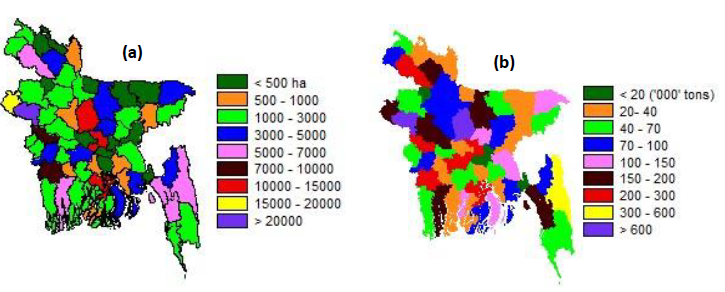
Figure 1: Average total fruit (a) areas and (b) production in Bangladesh (BBS, 2017)
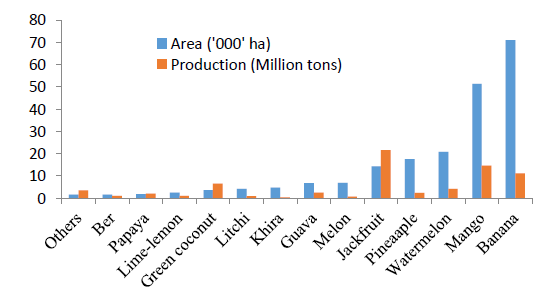
Figure 2: Major fruit crop areas and production in Bangladesh
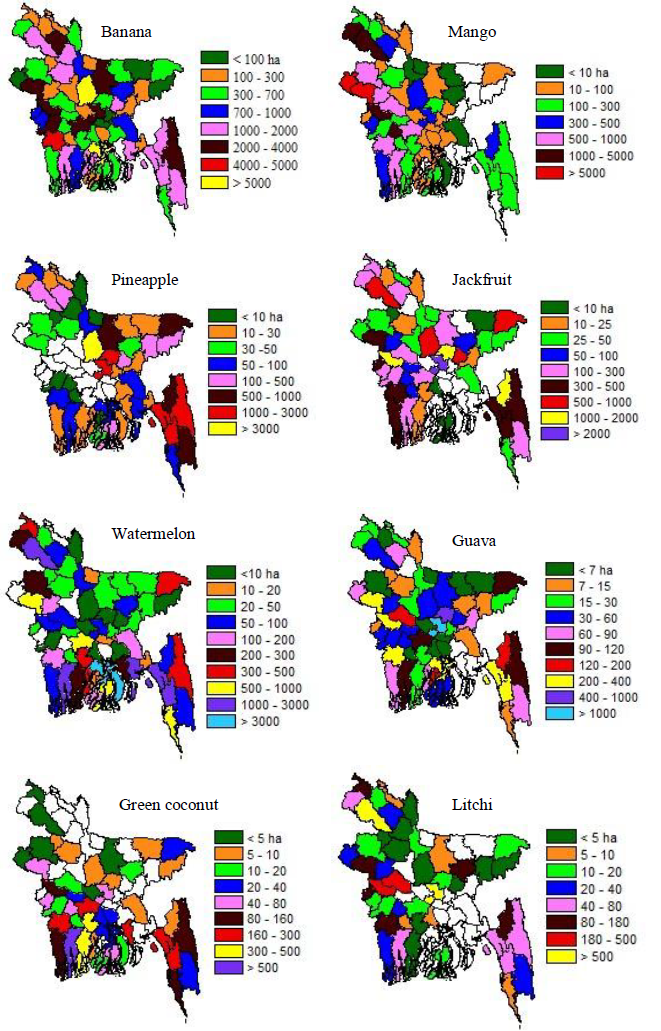
Figure 3: Major fruit growing zones (only garden areas) in Bangladesh
Major growing areas of eight selected fruit crops are shown in Figure 3. Banana garden in the range of 300-700 ha covered about 25% of the country followed by 1000-2000 ha garden in about 21% areas. The largest banana garden (5000 ha) covered only about 4.12% of the country. Mango does not grow in every corners of the country; but hilly areas in the south-east of the country are the hotspot for mango cultivation. Mango garden of 100-300 ha covered the highest area (27.98%) followed by 10-100 ha garden covering 24.04% areas of the country. The largest mango garden (>5000 ha) covers only 3.48% areas. Pineapple gardens are mostly concentrates in hilly areas (500-3000 ha) and Madhupur Tracts (1000 ha to >3000 ha) covering about 25% and 12% areas, respectively of the country. Jackfruit garden in the range of 100-300 ha covers about 22% areas followed by 300-500 ha covering 16.12% areas of the country. The smallest (<10 ha) and the largest (>2000 ha) jackfruit gardens covered 7.03% and 1.32% areas, respectively of the country. Watermelon grows in large areas (500 ha to >3000 ha) in coastal districts covering about 20.67% areas of the country; its smaller sized gardens (<10 ha to 50 ha) distributed in different parts covering about 37% areas. Small (<7 ha to 60 ha), medium (60-400 ha) and large (400 ha) guava gardens covered 59.88%, 37.63% and 2.48% areas, respectively of the country. Dominant green coconut areas are in southern (160 ha to >500 ha sized gardens) and south-east (5-300 ha) parts of the country. Litchi dominantly grows in north-west (40 ha to >500 ha gardens) and south-east (40-180 ha) regions covering about 34.82% and 26.07% areas, respectively of the country.
3.2 Socio-ecological vulnerability
North-east, south and south-east coastal regions of Bangladesh are moderate to very highly socio-ecologically vulnerable based on all evaluation methods except geometric mean approach (Figure 4). With the exception of a few districts, northern parts of Bangladesh are also vulnerable to very highly vulnerable. Based on all evaluation methods, most safe zones are situated in major hilly areas, parts of north-west region and a few districts in central region of the country. Based on estimation, very highly, highly and vulnerable areas were as high as 26.60%, 26.22% and 27.33% of crop areas (13829116 ha), respectively. No or slightly socio-ecological vulnerable areas are only 4-26%.
3.3 Natural hazards and economic loss
Fruit crop area damages were the highest in Khulna division followed by Chittagong and Barisal divisions, respectively (Figure 5a). Area damages followed the decreasing order of Khulna> Chittagong> Barisal> Dhaka> Rajshahi>Rangpur>Sylhet divisions. Similar trends were observed for economic losses because of climate extremes. Hailstorms were dominating hazards responsible for 28.83% losses followed by thunderstorms (14.73%), cyclone (14.54%) and salinity (10.86%) and the least was by the erosion (Figure 5b). Damaging effects of tornado and drought were 9.3-9.8% and that of flood, waterlogging, storm/tidal surge were 2.9-4.7%. Based on economic losses caused by climate extremes, about 67% areas of the country were moderate to highly vulnerable for fruit cultivation during 2009-2014 (Fig. 6). The rest areas were safe or comparatively safe zones for fruit cultivation.
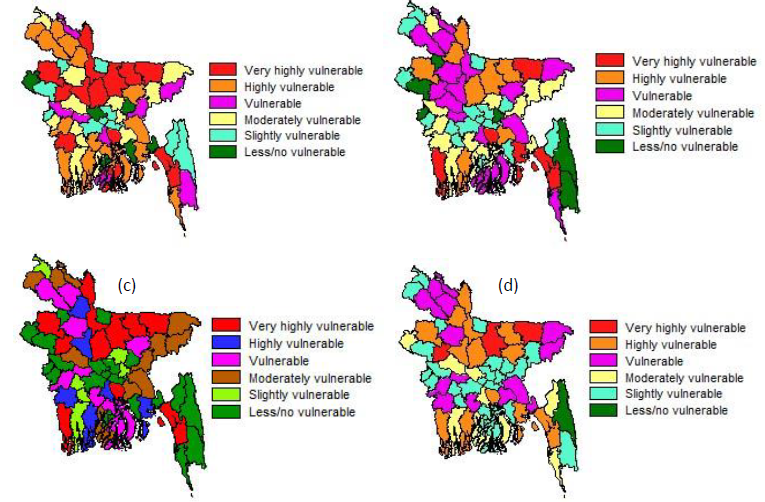
Figure 4: Socio-ecological vulnerable areas in Bangladesh based on (a) minimum of 10 attributes, (b) arithmetic mean, (c) geometric mean and (d) weighted mean.
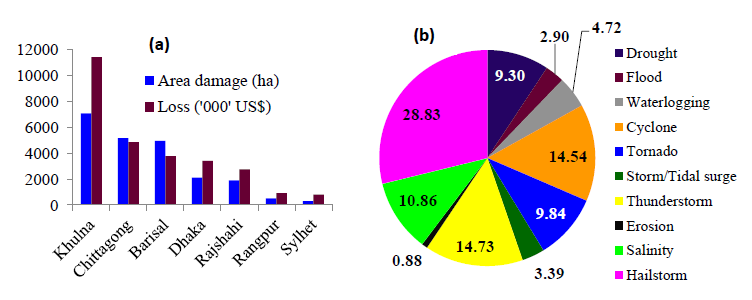
Figure 5: Influence of natural hazards on (a) division wise fruit area and economic losses and (b) damaging contribution (%) during 2009-2014
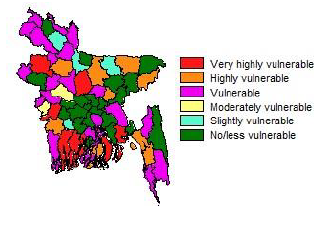
Figure 6: Fruit crop vulnerable zones in Bangladesh based on economic losses by natural hazards during 2009-2014
4. Discussions
Many tropical fruits are grown in Bangladesh and there are seasonal bounties in different parts of the country. Only five fruits dominate the country in terms of area coverages and their distribution vary depending on land and ecological suitability. So, total production from gardens and individual tress vary greatly among locations and thus the availability for consumption. Small gardens are more common in Bangladesh than larger one because of fragmented land holdings. Some fruit trees are seasonal and others are perennial and fruit bearing takes place in a particular time of the year and thus they exposed to different climate extremes. For example, banana, coconut, guava and papaya grow year-round and face different climate extremes based on fruit bearing times the crops (Figure 7). While on the other hand, pineapple, litchi, jackfruit and mango bear fruits in a particular season and so they are exposed to specific natural hazard(s). For example, litchi is exposed to tornado, hailstorm, thunderstorm and drought mostly because it grows in selected locations of the country in a particular season. On the other hand, mango grows almost every corner of the country and exposed to nine selected natural hazards (Figure 7).
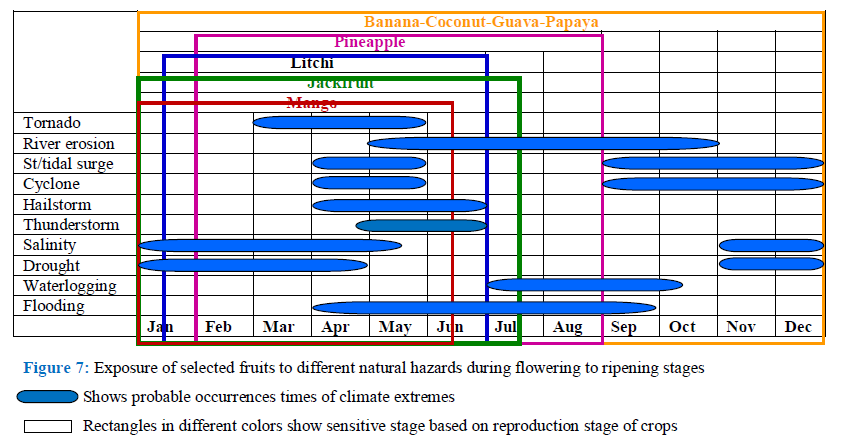
Figure 7: Exposure of selected fruits to different natural hazards during flowering to ripening stages
Shows probable occurrences times of climate extremes
Rectangles in different colors show sensitive stage based on reproduction stage of crops
Fruit plants may respond to avoid one or more stresses through morphological or biochemical mechanisms. Fruit shedding or reductions in size are the examples of coping mechanisms. Drought, a slow onset disaster is the single most important factor affecting world food security and it was the catalyst of great famine in the past. Bangladesh experienced severe droughts in 1951, 1957, 1961, 1972, 1976, 1979, 1986, 1989 and 1997 mostly occurring in pre-monsoon and post monsoon seasons depending on rainfall distribution pattern. Though drought is damaging for every living being, sometimes it helps in fruit bearing. For example, drought reduced vegetative flushes and mango malformation along with enhanced flower bud formation. Besides, water and oxygen are needed in sufficient quantity for growth and development. Drought not only affects agriculture, it also influences social life. Sometimes conflicts arise among neighbor because of water scarcity. In some areas crop fields have transformed into orchard for cultivation of mango, jujube and guava. Such practices are governed by many factors of which economy of the produce is the major driving force. Farmers generally apply supplemental irrigation water in many cases to minimize drought effects. Salinity imposes an initial water deficit that results from the relatively high solute concentrations in soil resulting in ion specific stresses of K+/Na+ ratios and leads to a buildup in Na+ and Cl- concentrations, which are detrimental to plants. Salinity affects plant growth and development in various ways through its impact on photosynthesis, water relations and nutrient absorption. If salt concentration exceeds threshold level, growth rate and size of plants decreased progressively along with reduced fruit yield. Banana, lemon, mango and orange are susceptible to salinity but coconut and guavas are moderately tolerant. Papaya shows variable sensitivity to salinity. Socio-ecological vulnerability largely depends on household income, knowledge on disaster management, disaster preparedness and occurrences and intensities of natural hazards. Mymensingh, Sylhet, Dhaka, Comilla and parts of Rangpur and Khulna regions are river-flooded zones in Bangladesh. So, under extreme flooded conditions like flood on 1998 would reduce fruit production considerably. In north-eastern Bangladesh, flash flood in April to November and water stagnation are the causes of socio-ecological vulnerabilities. As economy is one of the driving forces, it helps in preventing damages and recovery after natural havoc. We have found low income in Mymensingh, Barisal, Rangpur, etc areas where socio-ecological vulnerability is high. Alamgir et al. also reported the highest poverty rate in Mymensingh and Barisal and the lowest in Rajshahi areas. Based on geographic locations and considering other factors, the least or no fruit crop vulnerabilities were observed in Chapai Nawabganj district under Rajshahi division and most part of hilly areas of the country (Figures 4a, 4b). Wisner et al. also reported that if a community is characterized by social and economic development, vulnerability is minimized along with enhanced capacity of disaster management. Disaster mitigation policies need to be based on improving human experiences to natural hazards, not on relief activities after calamities. Moreover, development of disaster mitigation programs based on increasing adaptive capacity and reducing biological sensitivity to natural hazards can be effective strategy. Depending on types of hazards and intensities, losses in total fruit production and economic damages take place. Besides, hazards frequencies vary depending on locations of the country (Figure 8) and thus crop losses also vary. Frequencies of climate extremes are more than 50% in about 36% areas of the country. So, it is obvious that crop damages are inevitable in Bangladesh. Options remain for the growers are to plan cropping in such a way that at least some of the calamites can be avoided. Selection of tolerant/resistant varieties against climate extremes and making physical barriers for certain events like netting of litchi trees for preventing hailstorm damages are important. However, community based disaster management would be better option because socially and economically marginalized communities are more vulnerable to natural disasters. Lack of fundamental knowledge on cyclones and tidal surge along with financial capabilities of the communities make it difficult for mitigation of damages. So, damages caused by climate extreme could be reduced by awareness builds up and disaster preparedness among social communities.
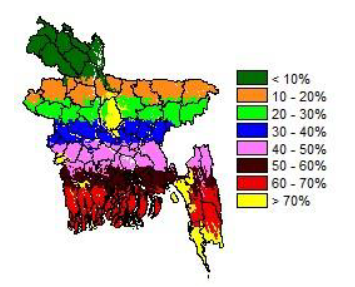
Figure 8: Climate extreme frequencies in different regions of Bangladesh
5. Conclusion
Considering area coverage, banana, mango, watermelon, pineapple, jackfruit, guava, khira and litchi are the dominant fruit crops in Bangladesh and they exposed to different natural hazards depending on growing seasons. The impacts of climate extremes on major fruit crop losses and socio-ecological vulnerability were investigated based on selected parameters that can be extended for exhaustive study at Upazilla (small administrative unit of a district) level. Since total fruit production from gardens and individual tress vary greatly among locations, proper distribution is essential for nutritional security of in the country. Although the country is disaster prone, major hilly areas, parts of north-west region and a few districts in central region of the country are safe for fruit production. However, damages from climate extremes in other parts of the country can be minimized by changing sowing times, selection of hazard tolerant/resistant varieties, making physical barriers, early warning for disaster preparedness and community based disaster management. Disaster mitigation policies should be based on improving human experiences to natural hazards, not on relief activities after calamities. Moreover, development of disaster mitigation programs based on increasing adaptive capacity and reducing biological sensitivity to natural hazards can be effective strategy. Community based disaster management would be better option because socially and economically marginalized communities are more vulnerable to natural disasters.
Acknowledgement
The research was partially funded by Krishi Gobeshona Foundation through CRP-II project.
Author’s contribution
Jatish Chandra Biswas, Md. Mozammel Haque and Md. Belal Hossain were involved in data collection. Jatish Chandra Biswas, Md. Maniruzzaman and Abdul Hamid analyzed data, performed mapping activities, and prepared the manuscript.
Conflicts of Interest
The authors declare no conflict of interest.
References
- Ahmed AU, Mirza MMQ (2000) Perspective on Flood 1998. University Press Ltd, Dhaka.
- Alamgir MS, Furuya J, Kobayashi S, et al. Farmer's net income distribution and regional vulnerability to climate change: An empirical study of Bangladesh. Climate 6 (2018): 1-36.
- BARI (Bangladesh Agricultural Research Institute) Handbook on Agro-technology. Second Edn. BARI, Gazipur (2000): 231-308
- BBS (Bangladesh Bureau of Statistics) Year Book of Agricultural Statistics-2016. Statistics and Informatics Division, Ministry of Planning, Government of the People’s Republic of Bangladesh (2017): 198-248
- BBS (Bangladesh Bureau of Statistics) Bangladesh Disaster-related Statistics 2015: Climate Change and Natural Disaster Perspectives. Statistics and Informatics Division, Ministry of Planning, Government of the People’s Republic of Bangladesh (2016).
- BBS (Bangladesh Bureau of Statistics) Year Book of Agricultural Statistics-2012. Statistics and Informatics Division, Ministry of Planning, Government of the People’s Republic of Bangladesh (2014): 115-127
- Capiati DA, País SM, Téllez-Iñón MT. Wounding increases salt tolerance in tomato plants: evidence on the participation of calmodulin-like activities in cross-tolerance signaling. J Exp Bot 57 (2006): 2391-24006.
- CDMP-II (Comprehensive Disaster Management Programme II) Vulnerability to Climate Induced Drought: Scenario and Impact. Ministry of Disaster Management and Relief (2013): 135.
- CGIAR (Consultative Group on International Agricultural Research) Applications of molecular biology and genomics to genetic enhancement of crop tolerance to abiotic stress- a discussion document. Interim Sci. Council Secre., FAO. (2003): 19-58
- Chakravorti BK, Sarker P, Atiur R, et al. The thunderstorm and lighting: The temperature effect on climate change of Rangpur region in Bangladesh. Sci J Energy Eng 6 (2018): 31-36
- Dastagir MR. Modeling recent climate change induced extreme events in Bangladesh: A review. Weather Climate Extr 7 (2015): 49-60.
- FAO/WHO (Food and Agricultural Organization/World Health Organization) Diet, nutrition and the prevention of chronic diseases. Repot of a Joint FAO/WHO Exper Consultation. WHO Tech. Report Series 916. WHO, Geneva (2003).
- George AP, Nissen RJ. Effects of drought on fruit set, yield and quality of custard apple (Annona spp. Hybrid) ‘African Pride’ plants. J Hort Sci Biotech 77 (2002): 418-427.
- GOB (Government of the People's Republic of Bangladesh) Bangladesh Climate Change Strategy and Action Plan, Dhaka, Ministry of Environment and Forests, GOB (2009).
- Goldmann E, Galea S. Mental health consequences of disasters. Annu Rev Public Health 35 (2014): 169-183.
- HIES (Household Income and Expenditure Survey). Report of HIES, Bangladesh Bureau of Statistics, Planning Div, Ministry of Planning, Dhaka, Bangladesh (2010).
- Jahan S, Gosh T, Begum M, et al. Mutritional; profile of some tropical fruits in Bangladesh: Specially anti-oxidant, vitamins and minerals. Bangladesh J Medical Sci 10 (2011): 95-103
- Islam MM. Country Report: People’s Republic of Bangladesh. ADRC Visiting Researcher Programme, FY2013B (2013).
- Khan MNH, Mia MY, Hossain MR. Impact of flood on crop production in haor areas of two upazillas in Kishoregonj. J Environ Sci Natural Resor 5 (2012): 193-198.
- Mahesh GB, Mayur D. Modern Techniques for salt stress management in fruit crops. IOSRJ Environ Sci Toxicol Food Tech 1 (2015): 19-23
- Miah MU. Assessing long-term impacts of vulnerabilities on crop production due to climate change in the coastal areas of Bangladesh. Bangladesh Center for Advanced Studies, Dhaka (2010): 12-128
- Mishra DS, Tripathi A, Nimbolkar PK. Review on physiological disorder of tropical and subtropical fruits: Causes and management approach. Intl J Agric Environ Biotech 9 (2016): 925-935
- Rahman M. Climate change, disaster and gender vulnerability: A study of two divisions of Bangladesh. Am J Human Ecol 2 (2013): 72-82.
- Rahman MR, Lateh H. Meteorological drought in Bangladesh: assessing, analyzing and hazard mapping using SPI, GIS and monthly rainfall data. Environ Earth Sci 75 (2016):10-26.
- Ramteke V, Sachin AJ. Salinity influence in tropical fruit crops. Plant Archives 16 (2016): 505-509.
- Ruane AC, Major DC, Yu WH, et al. Multi-factor impact analysis of agricultural production in Bangladesh with climate change. Glob. Environ Change 23 (2013): 338-350.
- Sarker, Biswas JC, Maniruzzaman M. Climate change adaptation and economic profitability: Crop land shifting to mango orchard in Rajshahi region. Bangladesh Rice J 18 (2014): 9-18.
- Tahir FM, Ibrahim M, Hamid K. Effect of drought stress on vegetative and reproductive growth behavior of mango (Mangifera indica L.). Asian J Plant Sci 2 (2003): 116-118.
- Tanji KK, Kielen NC. Agricultural drainage water management in semi-arid areas. Food and Agriculture Organization Pub (2002): 135-140.
- Titumir RAM, Basak JK. Effect of climate change on crop production and climate adaptive techniques for agriculture in Bangladesh. Soc Sci Rev 29 (2012): 215-232
- UNDP (United Nations Development Programme) (2004) A global report: Reducing disaster risk: A challenge for development, (http://www.undp.org/bcpr)
- Yamaguchi T, Blumwald E. Developing salt-tolerant crop plants: Challenges and opportunities. Trends in Plant Sci 10 (2005): 616-619
- Watson JT, Gayer M, Connolly MA. Epidemics after natural disasters. Emerging Infectious Diseases 13 (2007): 1-5.
- Wisner B, Blaikie P, Cannon T, Davis I. At Risk: Natural Hazards, People’s Vulnerability and Diseases. London: Routledge (2005).
